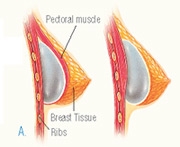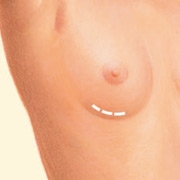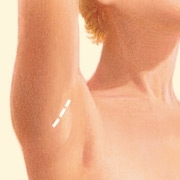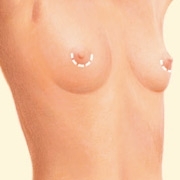Breast Augmentation
Breast augmentation enlarges a woman’s breasts through the surgical placement of breast implants. It is a cosmetic procedure performed to fulfill your personal desire for fuller breasts or to restore breast volume lost after weight reduction or pregnancy. Breast implants allow women the choice of fuller, natural appearing breasts and a more balanced figure.
Consultation with Dr Philip Fleming is the best way to determine how breast augmentation can help you achieve your personal goals. Dr Fleming is certified by the American Board of Plastic Surgery, Inc and he has more than 25 years of experience in performing breast augmentation. The following is an overview of the breast augmentation procedure.
Procedural Steps
Step 1 – Anesthesia
Breast Augmentation is most commonly performed under general anesthesia. You will be asleep and under the care of a board-certified MD anesthesiologist and a board-certified nurse anesthetist (CRNA). These health professionals will monitor you during your procedure, ensuring that you have a safe and pleasant experience.
Step 2 – The Incision
Your incision will be made in an in-conspicuous location to minimize visible scarring. Incision options include:
Incisions vary based on the type of implant, degree of enlargement desired, your particular anatomy, and patient-surgeon preference.
Step 3 – Implant Choice
Breast size and shape are important, so be honest and open about your expectations when talking with your surgeon.
Implant type and size will be determined not just on your desired increase in size but more importantly on your breast anatomy, skin elasticity and body type.
Options for Breast Implants
Saline implants are filled with sterile salt water. They can be filled with varying amounts of saline which can affect the shape, firmness and feel of the breast. Should the implant shell leak, a saline implant will collapse and the saline will be absorbed and naturally expelled by the body.
Silicone implants are filled with an elastic gel. The gel feels and moves much like natural breast tissue. If the implant leaks, the gel may remain within the implant shell, or may escape into the breast implant pocket.
A leaking implant filled with silicone gel may not collapse. If you choose these implants, you may need to visit your plastic surgeon regularly to make sure the implants are functioning properly. An ultrasound or MRI screening can assess the condition of breast implants.
Implant manufacturers occasionally introduce new styles and types of implants, so there may be additional options available.
Currently Saline implants are FDA-approved for augmentation in women 18 years of age and older.
Currently Silicone implants are FDA-approved for augmentation in women 22 years of age and older.
Saline or silicone implants may be recommended at a younger age if used for reconstruction purposes.
Step 4 – Insertion and Placement of the Implants
After the incision is made, a space (pocket) is formed by separating tissue layers. No breast tissue is removed. The pocket may be created in either of the following locations:
- Under the pectoral muscle (a submuscular placement), or
- Directly behind the breast tissue, over the pectoral muscle (a submammary/ subglandular placement)

The method for inserting and positioning implants depends on the type of implant, degree of enlargement desired, your body type, and your surgeon’s recommendations.
Step 5 – Closing the Incisions
Incisions are closed with layered sutures in the breast tissue and with sutures, skin adhesive or surgical tape to close the skin. Over time the incision lines will fade.

Step 6 – The Results
The results of breast augmentation are immediately visible. Over time, post-surgical swelling will resolve and incision lines will fade. Satisfaction with your new image should continue to grow as you recover and realize the fulfillment of your goal for fuller breasts.







